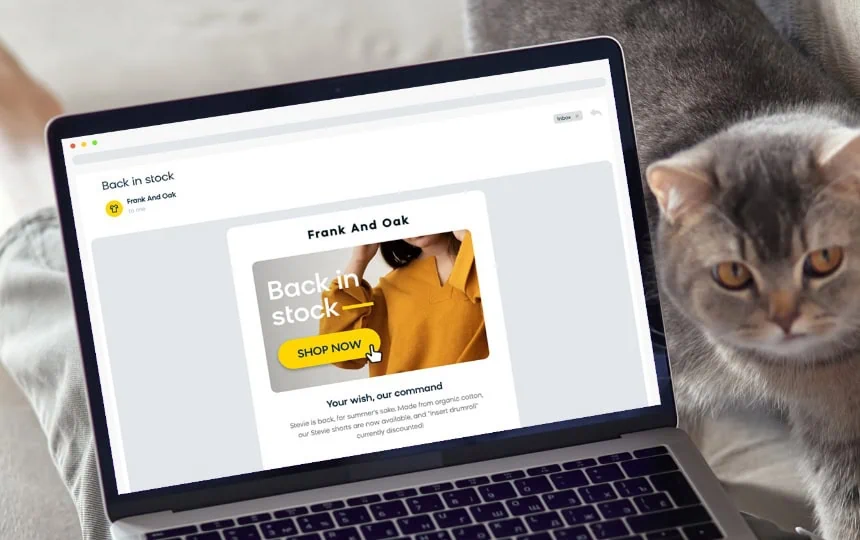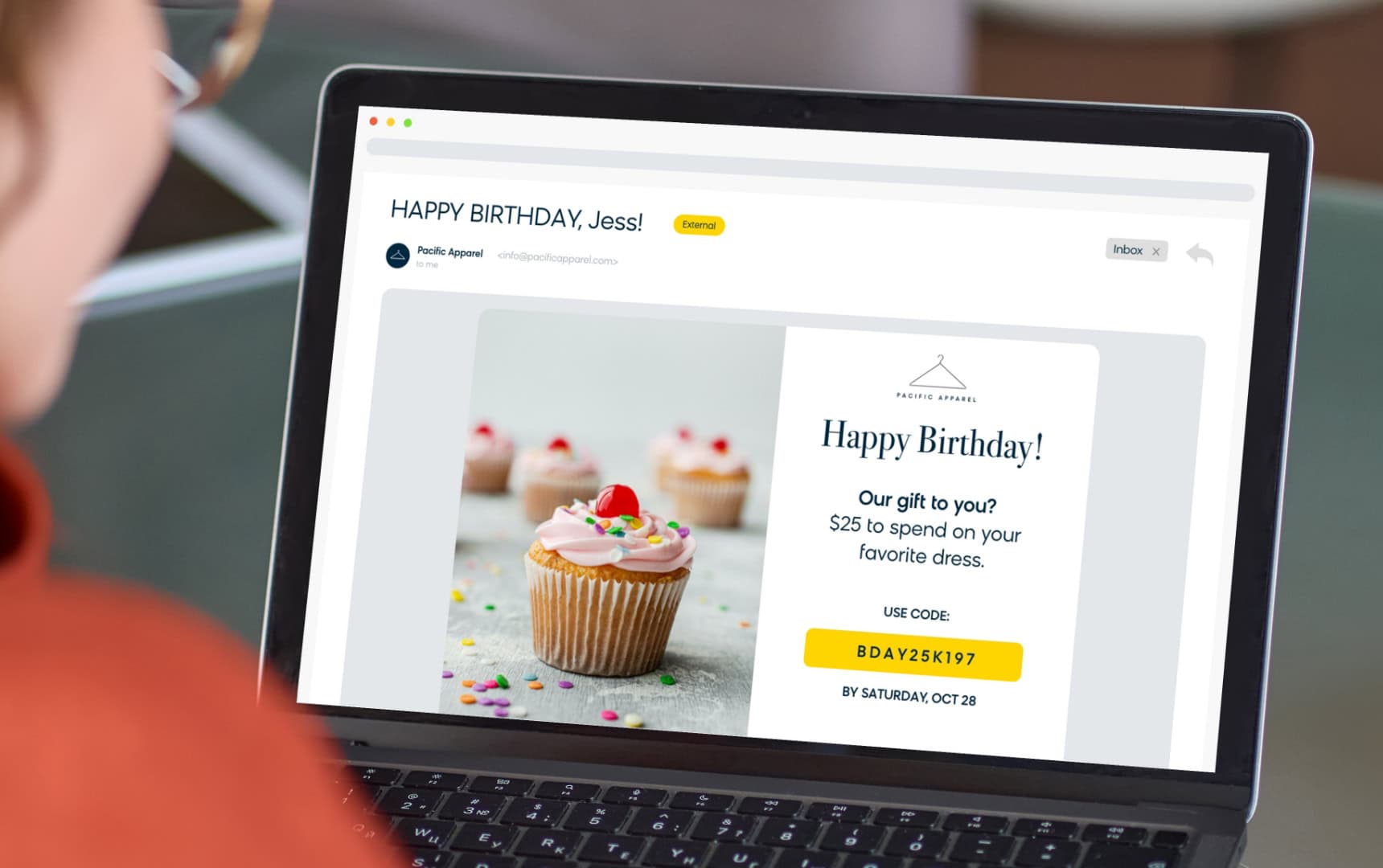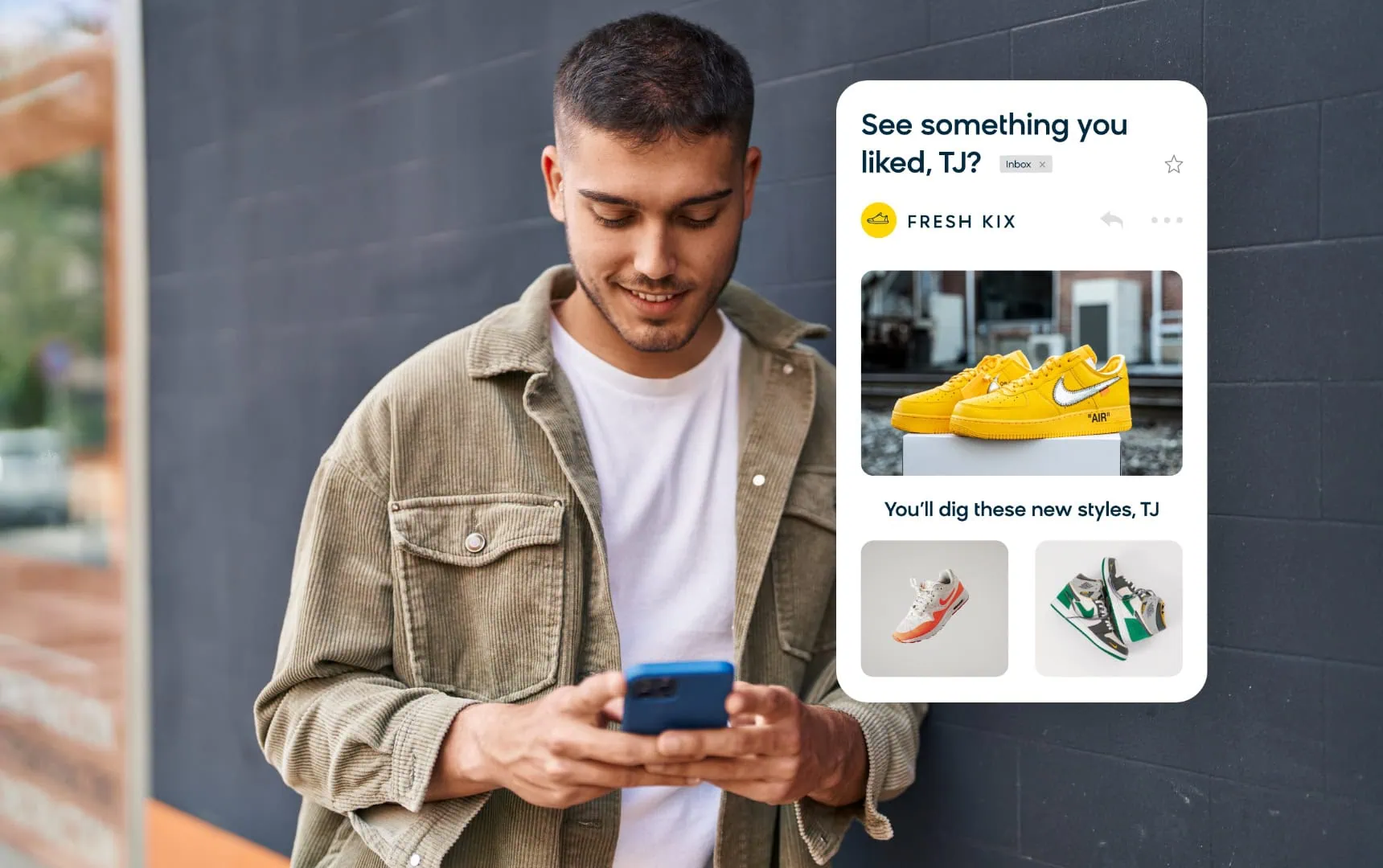Email remains one of the most effective marketing tactics. More than two-thirds (68%) of consumers prefer email as their primary communication channel with brands, while nearly half (46%) of B2B buyers prefer email for initial business contact — and marketers are 6x more likely to get a click-through from an email campaign than from social. Email marketing is so successful as an engagement tactic that on average, it delivers an ROI of $36 for every $1 spent, with top-performing organizations commanding $68 per $1 invested.
While email marketing used to just be a generic newsletter roundup of what a company had been doing or promotional pushes for new product lines, technology has driven big change. Today, email communications can be personalized, interactive, and automated.
Additionally, email is now integral to every part of the shopping journey because it provides an opportunity to continually nudge audiences toward certain actions. For example, Oliver Bonas increased its revenue by 762% through the smart use of email marketing, sending customers communications to opt in to certain segments, reminders, and abandoned-cart notices.
In this article, we look at what organizations can do to maximize the ROI of their email marketing efforts by examining industry benchmarks and implementing 8 proven strategies to boost conversion rates.
What Is the Conversion Rate in Email Marketing?
Put simply, the conversion rate is the percentage of people who perform the action specified in an email. For example, if an email was sent to 1,000 subscribers and 100 of them clicked a link to visit the website, the conversion rate is 10%.
The conversion rate matters because it provides a hard metric for the number of engaged customers who are most likely to purchase or recommend your product. It also provides insight into how organizations can enhance the experience to give customers what they want. By tracking how its emails behaved, Proffsmagasinet was able to improve its conversion rate by 2x and lower its unsubscribe rate by 65%.
However, while the conversion rate is typically tracked to define email marketing success, there are other equally important metrics:
- Open rate: Senders with good list health and an engaged audience will achieve 30-40% open rates on bulk emails
- Click-to-open rate: Calculated based on emails opened (vs. delivered), a good benchmark to aim for is 10.5%
- Bounce rate: Measures the number of emails left undelivered compared to the number of emails sent, which should ideally remain below 2%
Email Marketing Conversion Rate Benchmarks by Industry (2025)
When benchmarking, it’s more meaningful to do it against sector-specific data. The average email marketing conversion rate across all industries is 15.22%, but performance varies significantly by vertical.
Industry-Specific Email Conversion Rates
|
Industry |
Conversion Rate
|
|---|---|
|
Beauty |
1.92% |
|
Fashion |
1.4% |
|
Fintech |
5.8% |
|
Pets |
2.77% |
|
Food and beverage |
0.19% |
|
Grocery |
7.9% |
|
Furniture and home goods |
3.03% |
|
Outdoor equipment and sports |
0.06% |
|
Retail |
2.25% |
|
Telco |
2.27% |
|
Travel and hospitality |
2.25% |
|
B2B distributors |
2.14% |
|
B2B manufacturers |
2.18% |
|
Media |
4.16% |
These benchmarks vary significantly across industries due to several factors:
- Purchase frequency: Industries like grocery and beauty see more frequent purchases, leading to higher conversion rates
- Average order value: B2B and high-ticket items typically have longer consideration periods
- Customer behavior: Some industries naturally generate more immediate action from email communications
Email Marketing Conversion Rate Formula and Calculations
Calculating the email conversion rate couldn’t be simpler:
Email Conversion Rate = [No. of Conversions / No. of Delivered Emails] x 100
Step-by-Step Calculation Example
Imagine 10,000 emails are sent but only 9,900 are successfully delivered because the remaining 100 bounced. Of those 9,900 subscribers, 300 clicked the call-to-action button to find out about the new product launch. Therefore: [300 / 9,900] x 100 would equal a 3% email conversion rate.
Related Email Marketing Formulas
Understanding these additional calculations provides deeper campaign insights:
- Open Rate = (Opens ÷ Delivered Emails) × 100
- Click-Through Rate = (Clicks ÷ Delivered Emails) × 100
- Email ROI = [(Revenue – Investment) ÷ Investment] × 100
- List Growth Rate = [(New Subscribers – Unsubscribes) ÷ Total Subscribers] × 100
8 Proven Strategies to Improve Email Marketing Conversion Rates
Every day, people are bombarded with emails — 1 in 5 receive 16+ promotional emails per day. However, when the content, cadence, and timing of every email are personalized for every customer, boosting the number of conversions becomes achievable. Here are 8 proven strategies:
Strategy 1: Optimize for Mobile-First Experience
Nearly half (46% ) of all emails are opened from a mobile device — and these emails have a 65% higher likelihood of converting to drive traffic to a website. Therefore, it’s important to ensure emails are optimized:
- Use a short subject line (approximately 30 characters)
- Use white space and keep the copy as concise as possible
- Use larger fonts to improve readability
- Have a well-defined CTA button
Strategy 2: Implement Advanced Email Segmentation
Customer segmentation is the enabler for personalization, but it must go beyond demographics to segment audiences based on past behaviors, such as:
- Browsing activity
- Purchase history
- Average order value
- Type of orders
- Open and click-through rates for previous emails
Strategy 3: Master Pre-Open Personalization
Email personalization helps contextualize emails and keep them relevant to ensure they speak to a specific pain point at a specific point in time. There are three key places to implement personalization before an email is opened:
- “From” name: Over two-thirds (68%) of subscribers decide whether to open and read an email based on who it’s from
- Subject line: Nearly half (47%) of subscribers choose whether to open an email based on the subject line
- Preview text: Indicates to the recipient why they need to open and read an email
Strategy 4: Craft High-Converting Subject Lines
When a subject line includes the recipient’s name, job title, recent purchase, or any other kind of personalization, it’s 50% more likely to be opened.
Subject lines are arguably the most important part of an email because if they don’t entice the reader to click and open, the rest of the content will never be seen and acted upon. To write great subject lines:
- Use no more than 61-70 characters for highest open rates (ideally 30 to optimize for mobile)
- Drive curiosity with questions
- Use urgency to make the readers open it right away
- Include attractive numbers, such as discounts
- Make it personal — ideally to every customer
Strategy 5: Leverage A/B Testing for Continuous Optimization
A/B testing allows marketers to send two versions of the same email to different segments of their contact database to determine which performs better. With each test, a different variable can be tweaked, such as the subject line or call to action, to see what influences recipients the most. Best practices for A/B testing:
- Decide what conversion behavior to test
- Identify where subscribers are lost
- Come up with a list of potential changes that might fix the problem
- Use an A/B testing tool
- Analyze and act upon what the results say
Strategy 6: Deploy Contextual Personalization with AI
Contextual personalization takes A/B testing one step further by applying artificial intelligence (AI) to the process. Rather than serve all customers the best variant of a tested email campaign, contextual personalization serves the best version for each customer based on their preferences.
Personalized emails are known to increase opening rates by 26%, with 80% of consumers more likely to convert and purchase. It can have a huge impact on conversion rates: bimago increased its on-site conversion rate by 44%, and Whisker boosted its revenue per user by 112%.
Strategy 7: Focus on Automated Email Flows
Brands using Bloomreach’s email marketing automation workflows typically see significantly higher conversion rates compared to traditional broadcast campaigns. Key automated flows include:
- Welcome series emails (3% average conversion rate)
- Abandoned cart sequences (10-15% recovery rate)
- Post-purchase follow-ups (6.8% average conversion rate)
- Re-engagement campaigns for inactive subscribers
Strategy 8: Maintain Excellent Email List Health
Maintaining good email deliverability is crucial for conversion optimization. Follow these practices:
- Take care of email list hygiene
- Monitor the frequency of email campaigns (5-8 emails per month provides highest ROI)
- Make it easy to unsubscribe
- Reengage or remove inactive subscribers
- Create a great welcome email sequence
- Consider subscriber segmentation
- Create bonus or gated content
What Top-Performing Emails Get Right: Key Success Factors
Analyzing high-converting emails reveals consistent patterns that separate top performers from average campaigns:
Design Elements That Drive Conversions
- Single, clear call-to-action: Top performers focus on one primary action rather than multiple competing CTAs
- Mobile-first design: Ensuring optimal experience across all devices
- Scannable layout: Utilizing white space and hierarchy to guide the reader’s eye
- Visual product focus: High-quality product images that showcase value
Common Mistakes That Hurt Conversion Rates
Avoid these conversion killers that plague underperforming campaigns:
- Generic messaging: Sending the same content to all subscribers regardless of preferences
- Weak CTAs: Using vague language like “click here” instead of action-oriented copy
- Poor list hygiene: Continuing to send to unengaged subscribers, hurting deliverability
- Inconsistent branding: Emails that don’t match the brand experience users expect
Create Email Campaigns That Convert With Bloomreach Engagement

There are a lot of email tools out there, but to deliver the most personalized emails powered by cutting-edge AI, you’ll need a solution like Bloomreach Engagement. With email performance tracking and analytics and advanced segmentation techniques, you can create customer-centric email campaigns that take into account their preferences in real time — all without ever having to go through IT.
Brands using Bloomreach typically see significant improvements:
- Average conversion rate increases of 25-40%
- Recovery of 15-25% of lost revenue through optimized abandoned cart emails
- Improved customer retention through effective lifecycle marketing strategies
With over three-quarters (77%) of marketers experiencing an increase in email engagement over the last 12 months, individual conversion rates are likely to be much higher. For example, we have customers that have achieved 23% conversion rates on their campaigns.
By implementing these 8 proven strategies and leveraging industry benchmarks as your guide, you can transform your email marketing performance and achieve the conversion rates that drive real business growth.Learn more about Bloomreach’s high-converting email design templates to take the next step into next-level email campaigns.


















